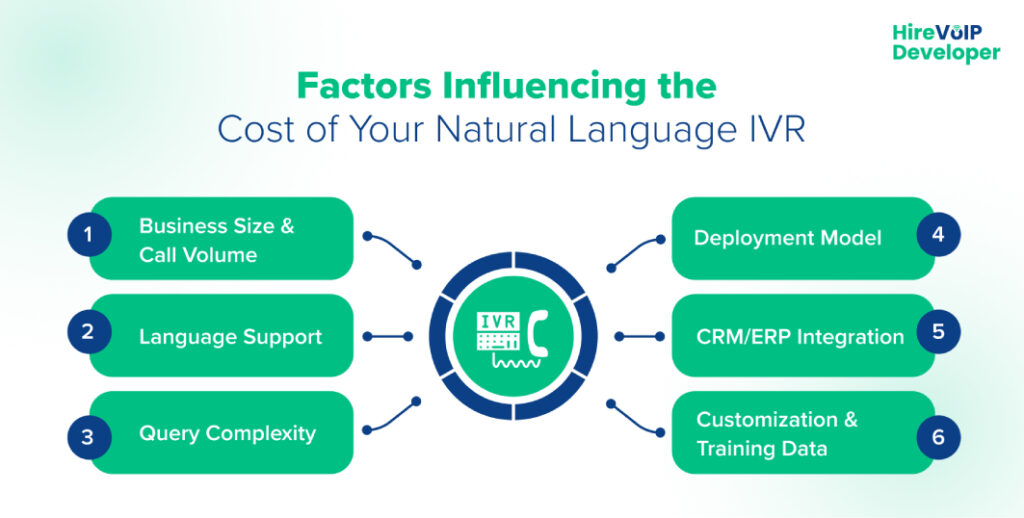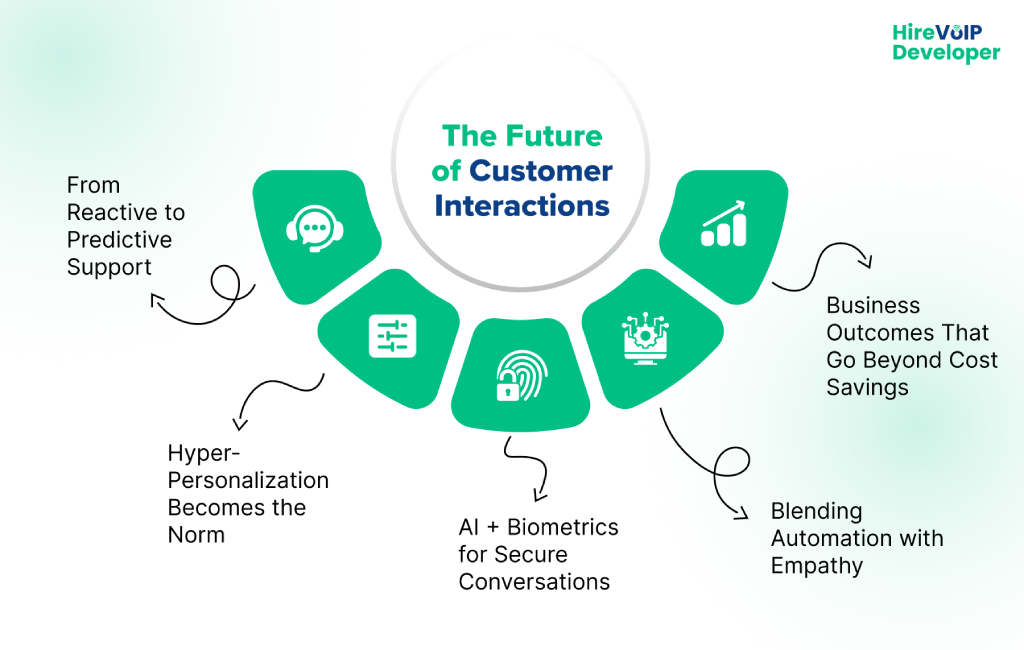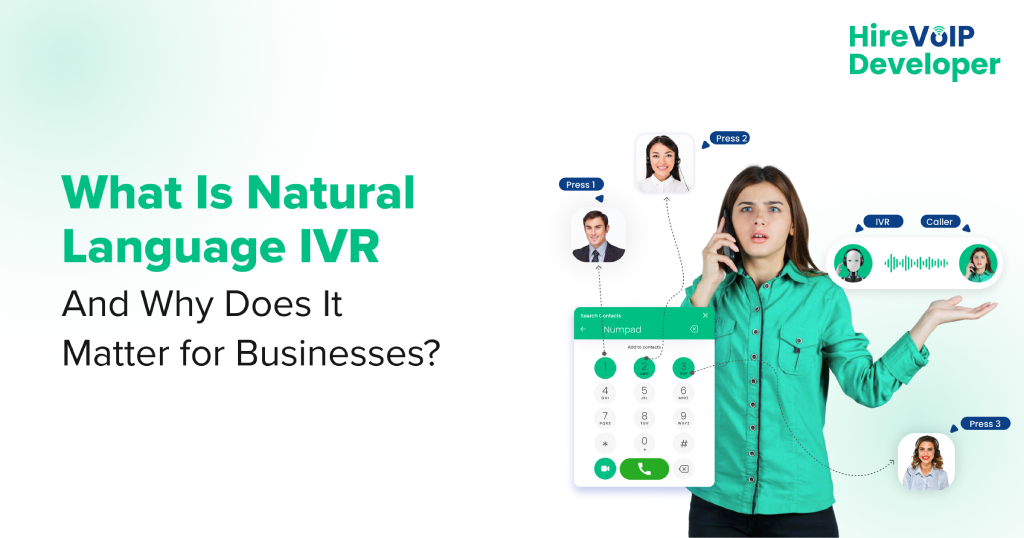📝 Blog Summary
Customers no longer want to press buttons; they want to be heard. Natural Language IVR transforms rigid menus into human-like conversations that save time, cut costs, and build loyalty. This blog shows you how to provide your customers with the customer care they desire.
In today’s market, customers don’t compare you to your closest competitor; they compare you to the best experience they’ve ever had. If your IVR still forces them through rigid menus while others offer fluid, conversational support, you’ve already lost the race.
The solution?
A custom natural language IVR solution with natural language understanding, which helps your enterprise turn a pain point into a competitive edge. Let’s dive deeper into this.
Is Your IVR Hurting Customer Satisfaction?
Most businesses still rely on outdated IVR structures built years ago. These IVR systems were designed to save time and cut costs, but ended up creating frustration instead.
- Menus are too long.
- Options don’t cover real-world problems.
- Callers often get bounced between departments.
The irony?
Companies spend millions on customer experience programs, yet their first line of interaction, the IVR, still feels like it belongs in the early 2000s.
But the real question is, why do Natural Language IVR solutions matter more today than ever before? Let’s take a closer look.
Why Natural Language IVR is Essential for Meeting Customer Expectations in 2025
Customer expectations have shifted. In 2025, people want interactions that feel seamless, not scripted. Whether it’s ordering food, checking a bank balance, or troubleshooting tech, the experience must feel natural.
That’s why natural language IVR providers are gaining so much momentum. It’s not just about efficiency; it’s about keeping pace with human expectations.
Natural language IVR addresses this by replacing robotic menus with conversations that feel more human. For businesses, the ripple effects are huge:
- Retention that sticks: When customers don’t have to wrestle with a machine, they’re far more likely to stay. Churn costs drop, loyalty goes up.
- Operational efficiency: Let automation take care of repetitive queries (account balance, appointment scheduling, password resets), freeing agents for high-value interactions.
- 24/7 service without the 24/7 payroll: A natural language IVR never needs a coffee break. Enterprises can expand availability without expanding headcount.
- Data as a hidden superpower: Every call becomes a dataset: what customers ask, where they struggle, how needs shift. Businesses can mine this data to refine both operations and product strategy.
- Scalable without painful hiring: Instead of adding more agents during seasonal spikes, scale with smart voice AI.

In short, natural language IVR isn’t just “customer support.” It’s a strategic layer that connects customer satisfaction to measurable business outcomes.
Natural Language IVR vs Traditional IVR
Here’s how natural language IVR outperforms traditional systems:
| Aspect | Traditional IVR | Natural Language IVR |
|---|---|---|
| Interaction Style | Menu-driven (“Press 1, Press 2”) | Conversational (“How can I help you today?”) |
| Flexibility | Rigid, predefined paths | Dynamic, adapts to customer input |
| Customer Effort | High—requires memorizing options | Low—customer just speaks naturally |
| Accuracy | Prone to misroutes | Uses IVR natural language understanding for context and accuracy |
| Experience | Frustrating and robotic | Human-like, empathetic, faster |
Both approaches have their place, but the choice depends on your business goals, your customers’ expectations, and your long-term CX strategy.
How Businesses Cut Call Center Costs With Natural Language IVR
Did you know?
Substandard customer service results in more than $62 billion in yearly losses for companies.
Call centers have always strived to strike a balance between delivering great service and managing high operational costs. But when agents spend most of their time handling repetitive queries or routing calls, costs climb while customer satisfaction falls.
Let’s take a look at how natural language IVR changes this equation.
- Fewer Agents Needed for Routine Tasks: By resolving common issues like account balance checks, password resets, or flight changes automatically, businesses reduce the number of live agents required for basic inquiries.
- Higher First-Contact Resolution: With access to CRM and ERP data, natural language IVR can solve more queries on the first call, eliminating the cost of multiple escalations.
- Smarter Resource Utilization: During peak traffic, natural language IVR absorbs overflow calls, ensuring agents focus on complex, high-value cases instead of simple requests.
- Compliance and Error Reduction: By integrating directly with systems (CRM, ERP, payment gateways), natural language IVR reduces human error in processes like billing or data entry, avoiding costly mistakes and compliance penalties.
Natural language IVR doesn’t just save money. It enables enterprises to scale efficiently, reduce agent burnout, and deliver the kind of seamless support that drives loyalty.
Factors Influencing the Cost of Your Natural Language IVR
The cost of implementing Natural Language IVR can vary significantly, depending on the complexity of your requirements and the deployment plan. Instead of an unrealistic one-size-fits-all price, here are the main factors that influence overall costs:

- Business Size & Call Volume: A small business handling under 10,000 calls a month will require far fewer resources than a large enterprise processing hundreds of thousands of calls. Higher call volumes naturally increase infrastructure and licensing costs.
- Language Support: Supporting the English language alone is straightforward, but offering multilingual or global coverage (5+ languages) significantly increases implementation and maintenance expenses.
- Query Complexity: Systems handling simple requests like balance checks cost less to build than those designed for complex, compliance-heavy interactions in sectors like banking or healthcare.
- Deployment Model: Cloud-based IVRs often operate on a subscription model with lower upfront investment, while on-premise systems may require higher initial costs but can reduce long-term fees.
- CRM/ERP Integration: A standalone IVR is cheaper to implement, but costs rise if you need deep integrations with CRMs (like Salesforce or HubSpot) or ERPs for advanced workflows.
- Customization & Training Data: Pre-built solutions are more affordable but less tailored. Training a system with industry-specific data and workflows adds cost but greatly improves accuracy and performance.
The bottom line is that Natural Language IVR implementation costs depend on scale, complexity, and integration needs. For most enterprises, investments can range from a few thousand dollars annually for basic deployments to significantly higher budgets for global, fully integrated systems.
Best Practices for Adopting Natural Language IVR
Rolling out advanced voice systems isn’t just about plugging in AI. Success comes down to design and execution. Here are some practical tips for adopting natural language IVR in 2025:
- Start Small: Don’t rebuild your entire IVR in one go. Identify the most common queries, like “account balance” or “appointment booking”, and automate those first.
- Multilingual Support: Customers expect to interact in their preferred language. Make sure your IVR supports multiple languages without awkward translation gaps.
- Seamless Human Handoff: Automation should never feel like a dead end. Always provide an easy route to a human agent when needed.
- Prioritize Clarity Over Complexity: Fancy AI features mean nothing if customers can’t understand how to use them. Keep responses simple and focused.
- Use Analytics for Continuous Learning: Track conversations. If customers keep repeating themselves, your system needs fine-tuning.
With these best practices, you can ensure that your Natural Language IVR delivers efficiency without compromising customer experience.
How Does Natural Language IVR Integrate with CRM and ERP Systems?
A natural language IVR that isn’t connected to your systems is like a receptionist who can greet visitors but doesn’t have access to the calendar, files, or team directory. Sure, they sound polite, but at the end of the day, they’re just pointing people down the hall.
Natural Language IVR integrates with CRM tools and ERP systems through a series of technical connections that allow data to flow seamlessly between your IVR and enterprise platforms. Here’s how it typically works:
- API-Based Communication: The IVR system connects to CRM and ERP platforms using secure APIs. This allows it to retrieve or update customer information in real time.
- Data Mapping: Customer interactions are mapped to corresponding fields in the CRM/ERP. For example, an account number entered or spoken by a customer is matched to their profile in the system.
- Contextual Query Handling: When a customer makes a request (“Check my order status”), the IVR queries the ERP system and retrieves the relevant data to respond accurately.
- Automated Updates: Actions taken by the customer during the IVR call (like payment confirmation or appointment scheduling) are automatically recorded in CRM/ERP without human intervention.
- Bi-Directional Data Flow: Not only does the IVR pull data, it can push data back into the systems for analytics, reporting, or follow-up tasks, ensuring complete visibility across teams.
- Security & Compliance Layer: Integration is done securely, often with encryption, role-based access, and audit trails to meet compliance requirements.
By connecting IVR with your CRM and ERP systems this way, enterprises achieve real-time personalization, smarter call routing, and operational efficiency, while maintaining data accuracy and compliance.
How Is Natural Language IVR Changing Customer Experience?
If the last decade of customer experience was about digitization, the next one is about humanization through AI. Natural language IVR is no longer just about making calls easier; it’s about transforming the way enterprises and customers interact at scale.
To see this transformation in action, let’s explore how next-generation IVR moves from reactive systems to proactive, personalized experiences.

1. From Reactive to Predictive Support
Today’s IVRs react: they wait for a question, then attempt to answer it. Tomorrow’s systems will anticipate needs before the caller even voices them. A bank IVR, for instance, could detect unusual card activity and proactively ask if the customer wants to block their card, even before the customer brings it up. This flips the script from support being a problem-solver to being a partner in prevention.
2. Hyper-Personalization Becomes the Norm
B2B buyers and end-consumers alike no longer tolerate “one-size-fits-all.” The future of IVR will merge customer data from CRM, ERP, and past interactions to deliver conversations tailored to the individual. Imagine an airline passenger calling in: instead of saying “How can I help you?”, the IVR might greet them with, “I see you’re scheduled to fly tomorrow. Do you want to confirm your seat or check baggage allowance?” That’s personalization that reduces friction and drives loyalty.
3. AI + Biometrics for Secure Conversations
Password resets, PIN verifications, and security questions slow down interactions. Voice biometrics, layered with AI, will soon authenticate customers passively within seconds. Enterprises get reduced fraud risk, while customers get the ultimate convenience: no more hoops to jump through.
4. Blending Automation with Empathy
AI won’t replace humans; it’ll empower them. The IVR of the future will know exactly when automation should step back and hand over to a human agent. It won’t just be about escalation; it’ll be about timing the transition so the human enters the conversation at the most impactful moment.
5. Business Outcomes That Go Beyond Cost Savings
Enterprises adopting next-gen IVR aren’t just saving on operational costs. They’re improving NPS, reducing churn, and building brand reputations as innovators in customer experience. In an era where “experience is the product,” this shift can be as valuable as any new service launch.
In short, Natural Language IVR is shifting from being a cost-saving tool to becoming a core driver of customer loyalty and enterprise growth.
Common Natural Language IVR Mistakes to Avoid
Even with the promise of AI-driven systems, companies often trip up. Here’s where most stumble:
- Over-engineering: Trying to make IVR do everything instead of focusing on what customers need most.
- Ignoring Emotion: Speech recognition is powerful, but it’s empathy that makes a system memorable. Tone, pacing, and phrasing matter.
- Neglecting Training Data: Without regular updates, IVR natural language understanding won’t keep up with evolving customer needs.
Learning from past missteps prepares businesses to take advantage of the next wave of IVR advancements.
The Future of IVR Technology
The world of IVR is evolving rapidly. Businesses are moving beyond traditional phone menus to more intelligent, responsive systems that enhance customer experience. Here are some key trends shaping the future of IVR:
- Omnichannel IVR: Voice interfaces extending seamlessly into chat, SMS, and even video calls.
- Industry-specific AI Models: Tailored IVR intelligence trained for finance, healthcare, telecom, and other sectors.
- Emotion-aware IVR: Detects caller frustration or satisfaction in real time and adjusts responses accordingly.
The future isn’t just about replacing old phone menus with better tech. It’s about creating conversational ecosystems where every interaction feels natural, secure, and personal. Businesses that embrace these trends won’t just keep up, they’ll set the benchmark for customer experience in their industries.
In a nutshell
IVR has been a necessary evil for years, but it doesn’t have to stay that way. With natural language IVR, businesses finally have a way to turn frustrating menus into meaningful conversations. And thanks to advances in IVR natural language understanding, it’s not about replacing humans; it’s about making every interaction feel more human.
If your system still makes customers feel like they’re trapped in an outdated phone maze, maybe it’s time to ask why. Because the future of customer experience isn’t about pressing buttons, it’s about having conversations that actually work.
Your competitors are already testing it.
Are you ready to lead?
Whether you’re a growing startup or a large, global enterprise, Hire Voip Developer’s consultative approach and end-to-end support make the shift to Natural Language IVR smooth, impactful, and future-ready. Get in touch today!


